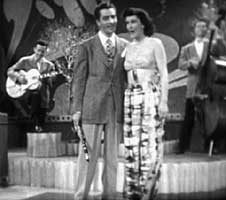 Tommy Reynolds & His Orchestra play I Don't Know Why (1946), sung as a duet by the bandleader & Phyllis Lane, who also sang with the Jack Teagarden Orchestra.
Tommy Reynolds & His Orchestra play I Don't Know Why (1946), sung as a duet by the bandleader & Phyllis Lane, who also sang with the Jack Teagarden Orchestra.
It's a lovely poky standard with the lyrics beginning after a xylophone solo: "I don't know why I love you like I do/ I don't know why you thrill me like you do/ I don't know why but I do."
At the instrumental break Tommy takes up his clarinet & out leaps Rose Marie McGill to perform a slightly crazed rapid hopping dance without regard for the slow beat of the tune. Her dancing is three-fourths burlesque shimmy & one-fourth ice capades whirling, absurd enough to be totally wonderful.
This was included in the three-soundie one-reel home-movie release from Official Films as Let's Dance (1947). The other items on that selection are Do Nothin' Till You Hear From Me (1944) & That Wonderful Worrisome Feeling (1946).
In the latter is a song that had a close brush with becoming a standard, composed by Al Hoffman, Allan Roberts & Jerry Livingston. It's performed by the usually goofy Al Trace & His Orchestra playing it serious, & Ann Parker singing the bluesy number.
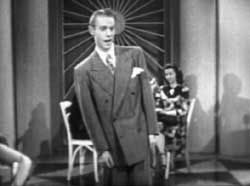 The former, Do Nothin' Till You Hear from Me (1944) features the Glenn Miller Modernaires. They consisted of five singers, four girls & a guy, never the same five for any two years running. As it begins, we get a virtual solo performance from one of the guys, & don't even see the other Modernaires. The former, Do Nothin' Till You Hear from Me (1944) features the Glenn Miller Modernaires. They consisted of five singers, four girls & a guy, never the same five for any two years running. As it begins, we get a virtual solo performance from one of the guys, & don't even see the other Modernaires.
The scrawny singer stands at an odd angle, as though about to tip over. He's center stage, surrounded by tables at which women are seated.
The sunburst wall panel behind the singer is seen in many soundies, used in various positions as part of a restaurant or club with a floor show, though of course it's just a stage.
This is a great song & it's sung well, & his crooked posture matching a crooked smile gives this guy considerable appeal, something like the very young Sinatra. It's odd he wasn't credited by name since the rest of the Modernaires aren't in evidence until halfway through the number.
Eventually the rest of the group comes out to harmonize with the lead, & it's frankly not as good a performance with the extra voices thrown in. The girl in the group in this year was Dorothy Claire who'd replaced by Marion Hutton & would soon be replaced by Paula Kelly.
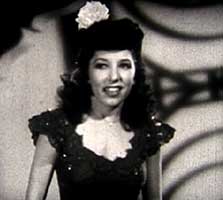 A nice if workmanlike swing song Now (1943) is sung by Vera Barton, the title word held long in each line of the lyric:
A nice if workmanlike swing song Now (1943) is sung by Vera Barton, the title word held long in each line of the lyric:
"Nowwwww, there's nothing more to say/ We've had a lovely day/ And lovely night times too./ Nowwwwww, we'd better say goodbye/ Don't say we didn't try/ To make it all come true."
Filmed separately on a miniature stage & spliced into Vera's performance at intervals are dancers Ann Parker & Danny Danford billed as the Shadowettes, because shown as romantically silhouetted dancers, an act likely concocted in the soundies studio.
Ann Parker was also a chorus girl so may additionally be the girl modeling on a pedistal while three other women dance or pose very foolishly in awful costumes the purpose of which was to show lots of leg.
Vera's a good enough singer she deserved better than this, but the panoram film directors were very much prone to adding leggy gals to entice sailors on shoreleave out of their nickles & dimes. A milquetoast soundie overall, though with period appeal.
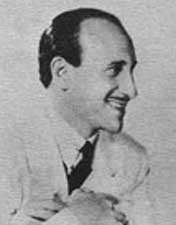 Joe Reichman & His Orchestra perform in the soundie If I Didn't Care (1942). Joe at piano looks at the audience & says four of his boys put together a little arrangement of the Inkspots tune. "Boys, how about doing it now for the soundies customers."
Joe Reichman & His Orchestra perform in the soundie If I Didn't Care (1942). Joe at piano looks at the audience & says four of his boys put together a little arrangement of the Inkspots tune. "Boys, how about doing it now for the soundies customers."
Four of the guys get up from the orchestra stand, two without instruments, one with slap-bass, one with guitar. They array themselves around a microphone & begin an almost-good impersonation of the Inkspots' 1936 hit.
They almost immediately begin adding comical tweeks that quickly go totally parodic, the lead tenor coughing to the bass singer's cigar, & competing for who can be closest to the microphone.
It gets goofier & goofier, all very witty & absurd. But how much better it would've been had the great & splendid Inkspots themselves been convinced to appear in some soundies, which they never did.
This soundie was selected for the title of a random compilation dvd called The Swing Years: If I Didn't Care (2004), the material ranging from Desi Arnas, to Will Bradley, Lawrence welk, the Mary Kaaihue Trio, Tiny Grimes, the King Sisters, & a lot more, including reviewed on the present page Now, The Sparkle Strut, & I Don't Know Why.
A curious error in the Swing Years soundies compilation discs, of which there are several, they are all bannered as being "music clips." But soundies aren't clips; they are films in their entirety. There is no restoration work done of the soundies so the quality is all over the place, mostly poor, with someone making the nutty decision to turn these black & white films brown & white. So whenver you can find the same soundies from other sources, do it.
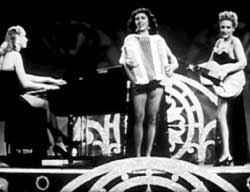 In The Sparkle Strut (1945), the Janette Hackett Dancers appear in skimpy burlesque queen outfits on a stage tricked out to look like a saloon. They wheel about on barstools then saunter-dance mid-stage as a chorus line.
In The Sparkle Strut (1945), the Janette Hackett Dancers appear in skimpy burlesque queen outfits on a stage tricked out to look like a saloon. They wheel about on barstools then saunter-dance mid-stage as a chorus line.
The dancers are awful but are only trying to duplicate a burlesque house look. They appear in at least four soundies but this is the only dance-soundie in which they are the complete focus of attention.
The music is provided by the Air Lane Trio, who are shown to be a cool group of gals likewise skimpilly clad playing organ, accordian, & guitar. These gals aren't really playing, however, & the finger movements on the guitar are especially comical in not fitting the music at all. The actual Air Lanes were three guys headed up by guitarist Tony Alessi, but we get no glimpse of them.
Not much of a soundie for either the music or the dance, The Sparkle Strut is significant in bridging the two panoram industries -- those which focused on musical acts, & those which featured "road show" striptease with those panorams placed only in adult arcades.
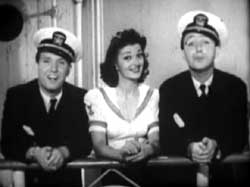 Frank Denning & His Orchestra backs up the vocal group The Smoothies in Gobs of Love (1942), composed by Redd Evans. Also known as Babs & Her Brothers, the Smoothies consisted of Little Ryan, Charlie Ryan, & Arlene "Babs" Johnson.
Frank Denning & His Orchestra backs up the vocal group The Smoothies in Gobs of Love (1942), composed by Redd Evans. Also known as Babs & Her Brothers, the Smoothies consisted of Little Ryan, Charlie Ryan, & Arlene "Babs" Johnson.
They starred in five soundies, including one for the better known Redd Evans' composition Rosie the Riveter (1943), in which they appear with the Cappy Barra Harmonica Boys. The Smoothies represented the best of mediocrity of the era.
Gobs of Love opens with a view of three women sitting on a concrete fence. Soon, a guy in his army uniform strolls into the picture to flirt. But when three sailors appear, the girls all but knock the army man over hurrying to the sailors.
A "gob" is a navy man, & this awful lyric begins: "Love, love, love for the navy/ Gobs & gobs & gobs/ Oh her heart skips a beat when a soldier she meets/ What it won't do when she sees a man in blue/ And she's got loads of hugs & kisses/ That's exactly what a sailor misses/ Everytime a fleet comes in/ She starts burning up within/ With gobs & gobs of love."
The dismal song had been a hit for the King Sisters, & to have girls singing "We start burning up with love" would at least have appeal for the gobs of the early '40s. This cover with the two brothers' voices dominant loses whatever slight sex-appeal it might otherwise have had as a wartime novelty number.
While the girls are shown hugging the sailors, the poor lonesome army guy dances & leaps trying to get attention, until the three couples leap on him & beat him up for no good reason.
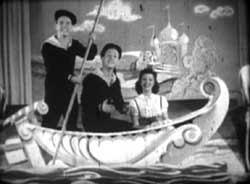 The film then jump-cuts to a set that looks like a ship's deck showing the Ryan brothers in naval officer uniforms, Babs between them, continuing the song. The film then jump-cuts to a set that looks like a ship's deck showing the Ryan brothers in naval officer uniforms, Babs between them, continuing the song.
Babs hasn't actually been singing as yet, but there's one more jump-cut showing her suddenly in uniform too, & she does a talk/rap bit. The camera cuts to a larger view of the stage, & the brothers are on this new set too, no longer dressed as officers but as English sailors.
There are two more jump-cuts for quite an elaborate soundie. The final set is quite beautiful if peculiar, with the Smoothies sailing a baroque barque right up to Sinbad's palace or perhaps the Taj Mahal, being apropos of nothing in the song.
For its excessive production the soundie's worthwhile, & even the awful song grows on you as they muck it up worse & worse until it's at least campy fun. It's no darned wonder, though, that nobody remembers the Smoothies.
I bet hardly anyone knew who they were even at the height of their "success," their biggest gig having been a series of appearances on the George Burns & Gracie Allens Show on the radio in 1940 & 1941, backed by Artie Shaw's orchestra.
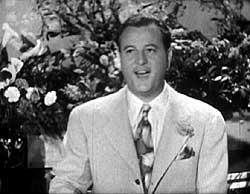 Gene Austin was a big star of the 1920s & did some good stuff into the 1930s. But by the time he made his half-dozen soundies, his star had long faded, & he was no longer very good.
Gene Austin was a big star of the 1920s & did some good stuff into the 1930s. But by the time he made his half-dozen soundies, his star had long faded, & he was no longer very good.
The back-up band for One Dozen Roses (1942) is unseen, but it's the studio band Harry Brent & His Orchestra.
The set looks like an alley beside a brownstone building. Gene is singing earnestly to another man: "You say my uncle left a million/ And half of it belongs to me/ Let us talk about that later/ It's important but love's greater/ Right now I'm busy as a bee./ I'm in an awful hurry, don't ask me now to stop/ I'm going to place an order in a little flower shop."
He walks around the corner into a flower shop & without missing a beat sings to the girl behind the counter: "Give me one dozen roses/ Put my heart in beside them/ And send them to the one I love," & so on, it's a nauseating song, & Gene has the nauseating face of a half-plastered uncle with bad breath & feely hands.
At the instrumental break, a delivery girl in hotpants dances down the street with a long box of roses. She dances to the door of Gene's girlfriend who is wearing a French maid outfit, delivering the roses.
This is one for which the elaborate staging feels more like slight of hand to trick people into not noticing how awful the song is.
Betty Clooney was just as talented & rather prettier than her older sister Rosemary, though Rosemary had by far the bigger career. Rosemary outlived her younger sister, & created a foundation in Betty's name for persons with traumatic brain injury.
Betty sings a number that had been a big hit for Doris Day, A Guy is a Guy (1952): "I walk down the street like a good girl should/ He followed me down the street like I knew he would/ Because a guy is a guy wherever he may be/ So listen while I tell ya what this fella did to me."
Betty almost seems to be attempting to capture Doris's persona & vocal inflection, a total impersonation, despite that she's brunette rather than blonde.
While she's singing this novelty number, she's in a hair salon addressing the lyrics to her nerdy hairdresser in glasses. Each verse describes stalker behavior encouraged by a flirt who apparently doesn't know bad things can happen.
I liked this song when I was a little kid because it has such kiddie-jingle appeal. Still, it really needs new lyrics, so I've been singing these:
"I walk to my house like a good girl should/ He followed me to my house like I knew he would/ I lead him in an alley where he tried to do me wrong/ So I whipped out my pistol & I shot him in the shlong."
Even with the real lyrics, if you really listen to them, it seems the girl's parents forced their daughter to get married after she was deflowered by a stranger. Damned weird. As the soundie ends, her husband comes to get her & is carrying groceries.
The lyrics to this silly song were by Oscar Brand cleaning up his nastier World War II soldier song "A Gob is a Slob." The original version is much more obviously making light of rape & how women like being forced to do it by unwashed stalkers. Oscar based it on an 18th Century drinking song "A Knave is a Knave" about a needy chap who got a decent woman pregnant then ran out on them.
copyright © by Paghat the Ratgirl
|
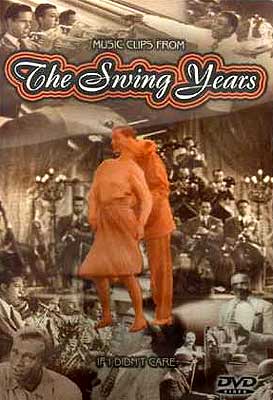

 The former, Do Nothin' Till You Hear from Me (1944) features the Glenn Miller Modernaires. They consisted of five singers, four girls & a guy, never the same five for any two years running. As it begins, we get a virtual solo performance from one of the guys, & don't even see the other Modernaires.
The former, Do Nothin' Till You Hear from Me (1944) features the Glenn Miller Modernaires. They consisted of five singers, four girls & a guy, never the same five for any two years running. As it begins, we get a virtual solo performance from one of the guys, & don't even see the other Modernaires.



 The film then jump-cuts to a set that looks like a ship's deck showing the Ryan brothers in naval officer uniforms, Babs between them, continuing the song.
The film then jump-cuts to a set that looks like a ship's deck showing the Ryan brothers in naval officer uniforms, Babs between them, continuing the song.